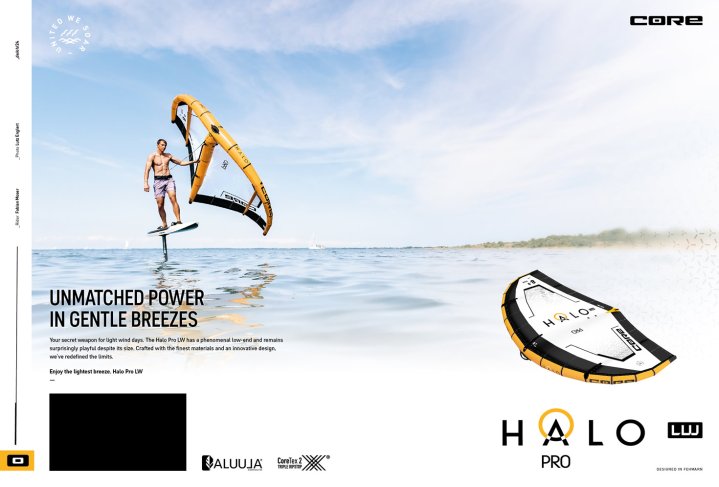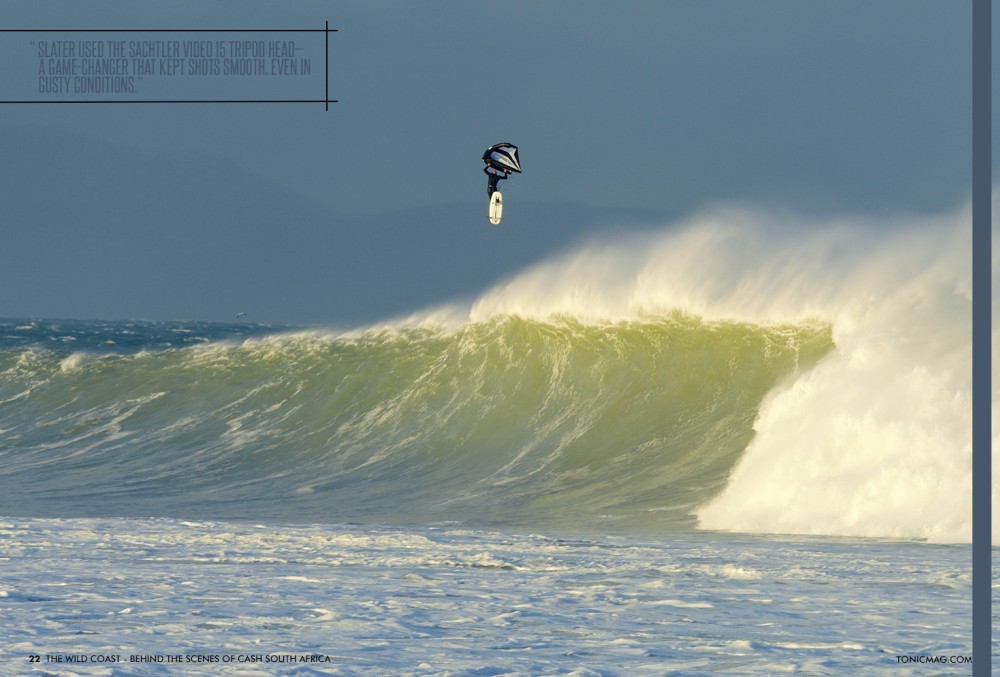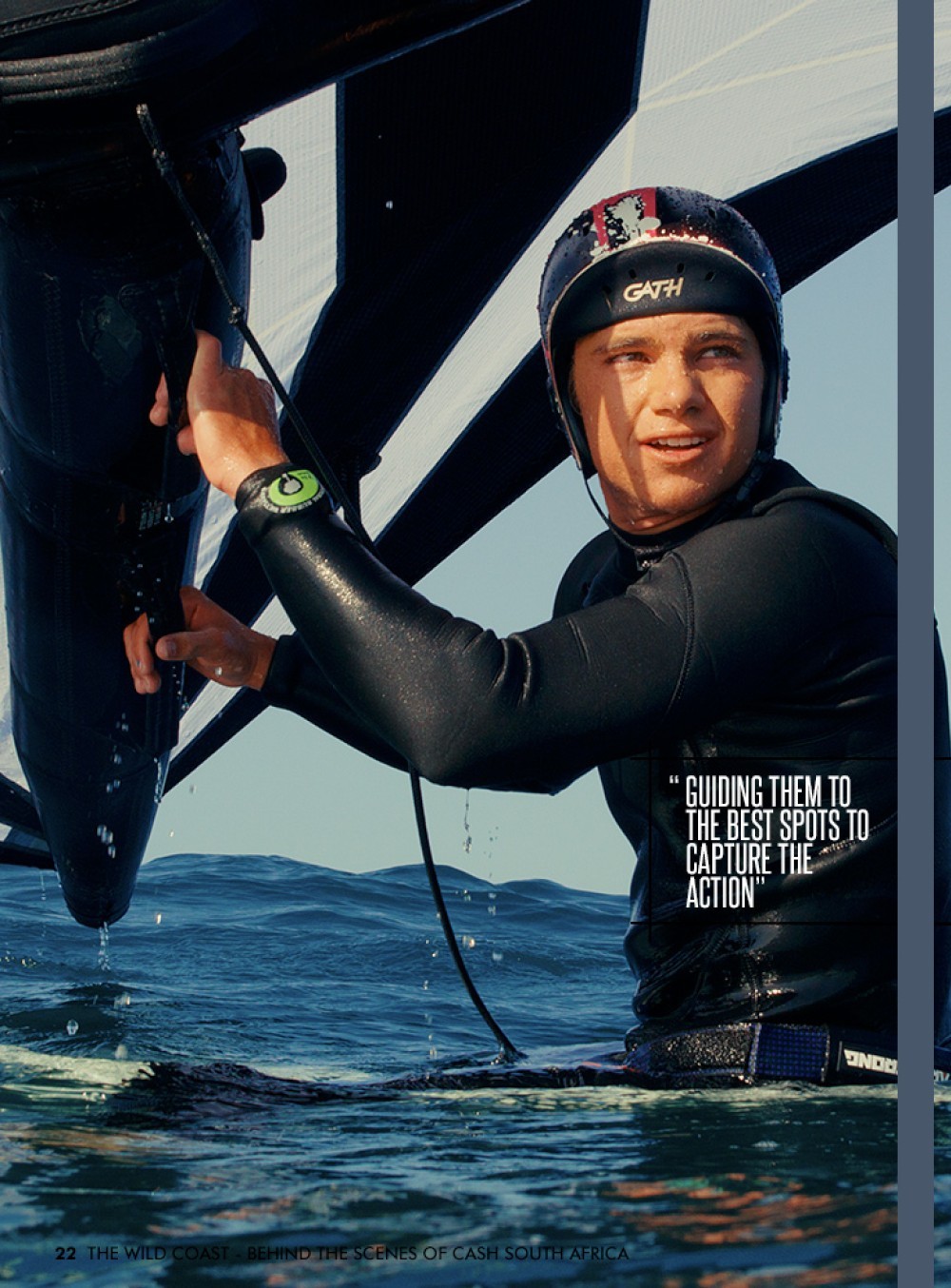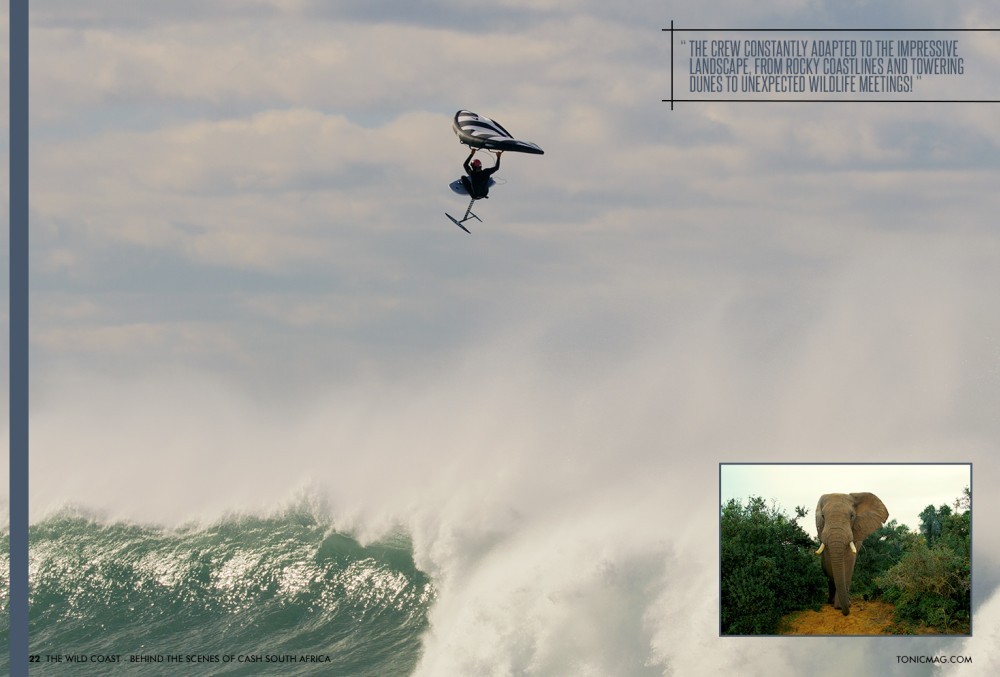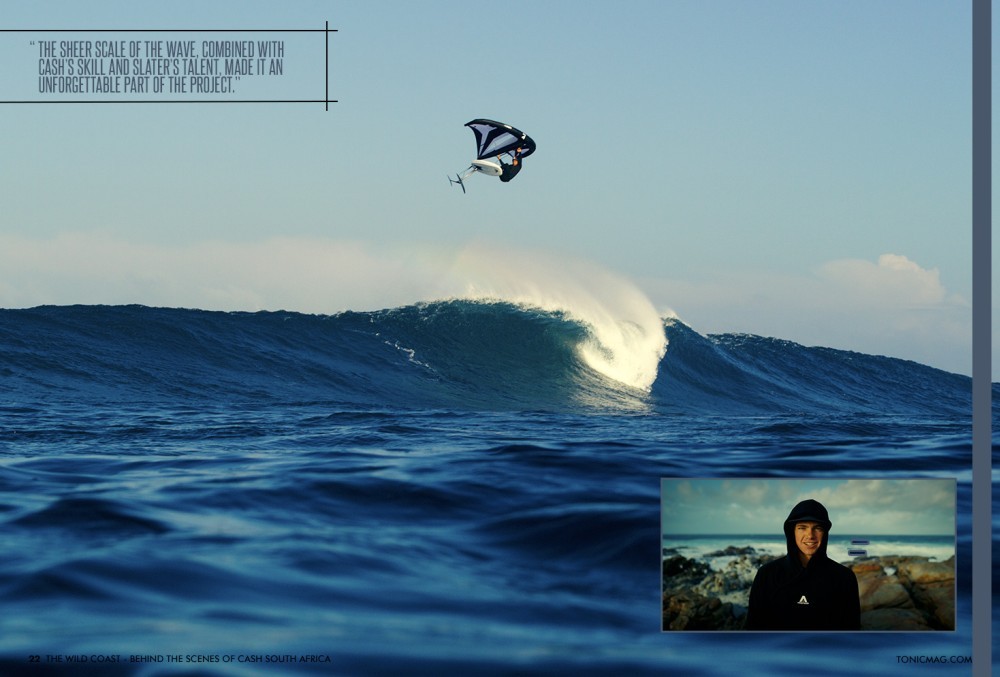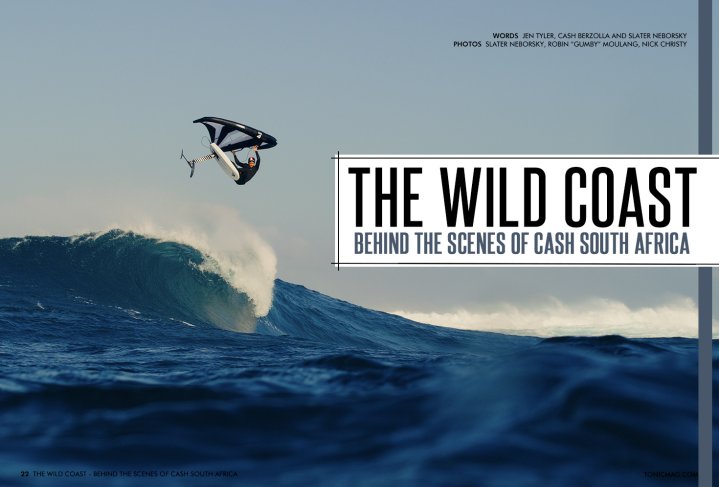
The Wild Coast - Behind the Scenes of CASH
Issue 22 / Thu 21st Nov, 2024
Armstrong Foils team rider and recently minted GWA Wingfoil Wave World Champion Cash Berzolla, cinematographer Slater Neborsky, and local legend Robin “Gumby” Moulang took on South Africa’s epic swells in July, capturing the daring world of big-wave foiling in high-res. Armed with the best gear, they ventured across the rugged coast, pushing foiling and filmmaking boundaries. Jen Tyler chats with them and uncovers what went on behind the scenes in this exclusive feature.
South Africa set the stage for an unforgettable trip as Cash Berzolla teamed up with cinematographer Slater Neborsky and local film legend Robin “Gumby” Moulang to create a one-of-a-kind film showing the daring world of big-wave foiling. They planned to chase massive swells and capture each moment in stunning, high-res footage that would elevate the visual experience and challenge the usual foiling films. With some of the best filming equipment on the market, the team ventured across the South African coast, battling conditions and logistical challenges to push the sport—and their storytelling—to new extremes!
Cash’s journey to South Africa began with a vision to foil Jeffrey’s Bay, one of the world’s most iconic surf spots. The idea of capturing this on film wasn’t initially part of the plan. Still, as he dreamed of wingfoiling the renowned break, he realised that documenting it would bring a new level of inspiration to the foiling community. The trip was as much about exploration as it was about progression, a chance to create something that captured the wild essence of South Africa’s coast and the thrill of foiling on some of the biggest waves out there.
“I never really thought about pushing the sport and its boundaries. I was so excited to go on a strike mission, which I had dreamed of doing since I was a little kid. Little did I know I would have two world-renowned filmmakers telling me what to do and making me look good. This is by far what made the short film what it was; it wouldn’t have happened without Slater and Gumby. Both of these guys didn’t seem to search for the perfect shot but instead managed to find it on every wave. Whether shooting on land, in the water, or from the sky, every shot was needed, making the film more diverse and exciting.” - Cash.
When it came to equipment, Slater wasn’t willing to compromise, and he made a strict rule: no GoPros or iPhones! While these cameras serve their purpose, Slater knew achieving a cinematic look required a far higher resolution. They shot most of the footage in 5K or 8K, making sure that each wave, turn, and aerial shot kept the same level of clarity. Slater brought a fleet of three RED DSMC2 cameras, including the RED Monstro VV 8K, for lifestyle shots. They used two RED Helium 8K cameras for action, one for land-based shots and the other for underwater housing.
Slater’s creativity and energy made him a total force on set. Fueled by endless coffee, he was more than just the filmmaker; he was also the hype man, strategist, and go-to problem solver, bringing a dedication that Cash loved. Cash was blown away by Slater’s ability to capture gritty realism and cinematic beauty, managing to find the perfect shot on every wave. With Slater’s experience in the surf industry and his eye for the best angles, Cash could just focus on his riding, knowing each moment was in good hands. “Slater's creative eye and nonstop energy elevated the project,” Cash said. “His presence brought the whole film together—he’s not only incredibly talented but just a great guy to work with.”
Each camera choice played a specific role. The team brought a RED Komodo X, sourced locally, as an emergency backup and a DJI Mavic 3 drone for aerial shots in 5.2K resolution. They also used a set of Xeen Cinema Lenses, primes T1. 5 16mm, 24mm, 35mm, and 85mm for most of the shots on land and in water housing. The difference in quality from standard lenses was noticeable, with the Xeen lenses giving the film a high-end feel. A Sigma 150-600mm lens Captured long-distance shots, and for stability against intense wind conditions, Slater used the Sachtler Video 15 tripod head—a game-changer that kept shots smooth, even in gusty conditions.
Transporting all this equipment across South Africa’s remote coastlines was no easy feat! Cash, Slater, and the team travelled in a truck and van, carrying all the equipment in large Pelican cases. Early starts, with the gear loaded and heading out before sunrise to catch the best conditions. Moving the equipment in and out each day was tiring, but it quickly became part of the rhythm of the shoot.
No film of this scale could come to life without a dedicated team. Alongside Cash and Slater, Gumby worked as both guide and cinematographer, capturing aerial footage with the DJI Mavic 3 drone and diving into the water with the RED cameras for up-close shots. His local knowledge of the tides and conditions made him a valuable team member. Gumby was crucial for many of the water-based shots, and his drone work highlighted the sheer scope of the South African coast.
Gumby led the crew through unknown terrain, sharing his insights on each location and guiding them to the best spots to capture the action. They used iPhones for initial scouting, photographing potential angles to refer back to once the shooting began. This planning helped the team stay efficient, making sure they’d be ready when the big waves hit.
Nick Christy joined the crew for two of the biggest days of the swell, capturing a third camera angle. Then there was the water safety team: Dustin Harding and Jole Dace, stationed on jet skis, ready to keep Cash safe and get him out of dangerous situations quickly. Their support allowed Cash to take risks, knowing he had a solid backup in case conditions got sketchy.
“The team we put together was made up of the absolute best for a project like this—no weak links whatsoever. With decades in the film industry and unmatched knowledge of the area’s logistics, Gumby was essential. Nick Christy and I, fresh from the surf industry and working full-time with athletes like Jordy Smith and Albee Layer, brought a wealth of experience in capturing the best possible shots in waves like these, so we needed almost no briefing on how to get ‘the shot.’ When the big day comes, everyone knows the drill.” - Slater
The trip wasn’t without its risks. Wingfoiling and foiling involved navigating powerful swells and dealing with unpredictable conditions, and Cash knew the importance of safety protocols. The jet ski was essential, allowing quick pick-ups if he was too close to rocks or in a dangerous situation. Foiling near jagged rocks, especially on waves he’d never seen before, was nerve-wracking. “There's always a certain level of controlled chaos,” Cash said. “You just have to assess the situation, know your limits, and then go for it.” The safety measures allowed him to push boundaries while staying grounded, making even the sketchiest sessions manageable.
“Foiling is super fun, but the risks are real, so safety was our priority. The jet ski was a game-changer, giving us rapid pick-up options in case things got sketchy—especially when foiling waves we’d never seen before, right in front of rocky areas. With Jole Dace at the helm and two other filmmakers watching the action, I felt safe pushing boundaries. Most sessions felt intense since every wave was new to me. “Controlled chaos” sums it up—there’s a balance of assessing the risks and just going for it. One memorable off-water moment came on a windless lay day when we ventured out to spot wildlife. After hours of seeing zebras, water buffalo, and ostriches, we entered a dense area of thorny trees. Suddenly, a massive elephant appeared, stopping us in our tracks. For a brief second, I thought of tossing Slater out of the van, but we just watched in awe. Slater, of course, managed to capture the whole surreal encounter. It was probably the craziest, albeit not the safest, moment of the trip!” - Cash.
South Africa was more than just a filming location; it provided a wild and rugged backdrop that brought a new level of intensity to the film. The crew constantly adapted to the impressive landscape, from rocky coastlines and towering dunes to unexpected wildlife meetings! On a lay day, they explored the local area, hoping to spot some of South Africa’s iconic animals. What started as a casual drive through the wilderness quickly turned into an adrenaline-pumping encounter when a massive elephant emerged from the brush, stopping the team in their tracks. Slater, camera in hand, managed to capture the entire experience.
“South Africa was such a different and raw environment from what Cash and I were used to, so we just wanted to see and experience everything—and make a film that captures that diversity. It’s not just about the riding for us; it’s about the journey and the culture surrounding it. From rugged coastlines and dunes to elephants and everything in between, we packed in as much as possible and filmed it all.” - Slater.
One of the most unforgettable moments of the trip came during Cash’s unexpected ride at Jeffrey’s Bay. Initially, the team had set up to shoot at another spot, but Cash caught up in the power of the swell and ended up riding a massive wave at J-Bay, South Africa’s premier big-wave spot. Realising the opportunity, Slater grabbed his 35-pound rig and sprinted along the coast to capture the shot, eventually setting up on a boardwalk as Cash rode a 15-foot wave. The energy at that moment was electric, with Cash riding a line he’d only dreamed of, and Slater managed to capture the shot from the perfect angle.
This wave was the film’s highlight, encapsulating the trip’s spirit and the team’s determination. It was a moment that would have been impossible to plan but became one of the defining images of CASH. The sheer scale of the wave, combined with Cash’s skill and Slater’s talent, made it an unforgettable part of the project.
We hope you enjoy the video!
Videos
By Jen Tyler
Italian/Egyptian Jen Tyler grew up on the sandy beaches of the Red Sea and has been on the IKSURFMAG & Tonic Mag team since 2017.


